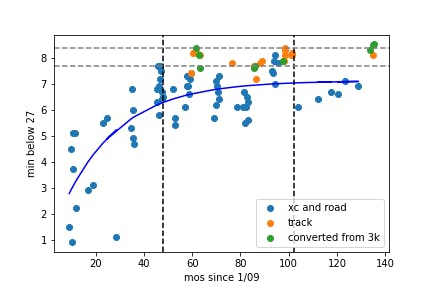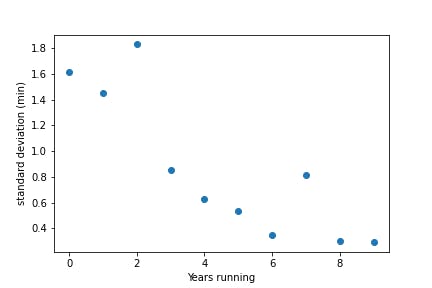Can I still PR?: A data junkie’s reflection on 12 years of 5ks
By: Sara Vannah
Like many runners, I’m a data junkie. I fret over my weekly mileage being low by a fraction of a mile, pore over old race results, and compare workout splits from season-to-season and year-to-year. Recently, I decided to use this to my advantage to answer one of my favorite questions – can I PR in the 5k? And if so, how much of a stretch is it?
I compiled all of the 5ks I’ve logged over 12 years of running, mostly cross country. I ran the 5k in track a few times, but those tend to be faster than running on trails or roads so I included a separate track dataset, as well as some 3k times from track that I converted. I added black dashed vertical lines for my high school and college graduations, which represented big changes in training for me, and gray dashed horizontal lines for my PRs coming out of high school and college.
PRing part 1: Do runners really plateau?
About a decade ago, I read an article that said runners competing in one event tend to plateau after a few years. To me, a “plateau” means that times will exponentially approach some upper limit so I fit my cross country and road data with a line that exponentially approaches some upper limit.

Right off the bat, I was bummed to see just how flat the tail of the exponential is today. A quick analysis of the residuals – the difference between my raw data and the exponential model, which should show only random noise for a good model – showed that that the exponential fit was a decent one.
While my times follow an exponential trend, it’s easy to see my “good” or “bad” seasons in the data. All of the blue points at ~80 months (fall of ‘15) are below the trendline, while nearly all the points at ~90 months are above the line. To me, this shows that fitness isn’t dictated by the exponential. Improvements in training, recovery, mental strategies, nutrition, etc. can still pull you off the exponential. I’m choosing to interpret this as yes, I can absolutely continue to grow more fit and run faster 5ks. The exponential only rules if we continue to run exactly the same.
PRing part 2: How much can I trust a good or bad race result?
One of my biggest pet peeves is self-critical runners calling a good race a “fluke”. You can’t fake fitness. However, there is a large amount of variance in how well fitness manifests itself in a race – no runner needs examples of just what can go wrong in a race.
The easy answer to this was to use the standard deviation over the course of a season. Obviously this is an imperfect measure since I tend to improve over the course of a season, but large leaps in performance tended to be over larger timespans. I found that over time, the variation decreased quite a bit – as a new runner, my times were all over the place! By 8 years of racing 5ks, I was skilled at pacing myself and racing hard. My standard deviation dropped down to about 20 seconds. This means that I am normally running with 20 seconds of a PR, that perhaps all I need is a good day! It also means that I should stop beating myself up for running, say, 10 seconds slower one week than a week prior. All of this is normal variation.

In conclusion – yes, runners (or at least me!) eventually plateau – but only if they keep training the same. Racing skills develop over time and they’ll grow much faster as a beginner, but there’s always room to experiment. This winter, I experimented with running lower mileage and resting more. This brought me to the cluster of green and orange dots on the far right of the plot – more PRs! My increased consistency has meant fewer wasted efforts in the quest of endlessly slicing off precious seconds.





